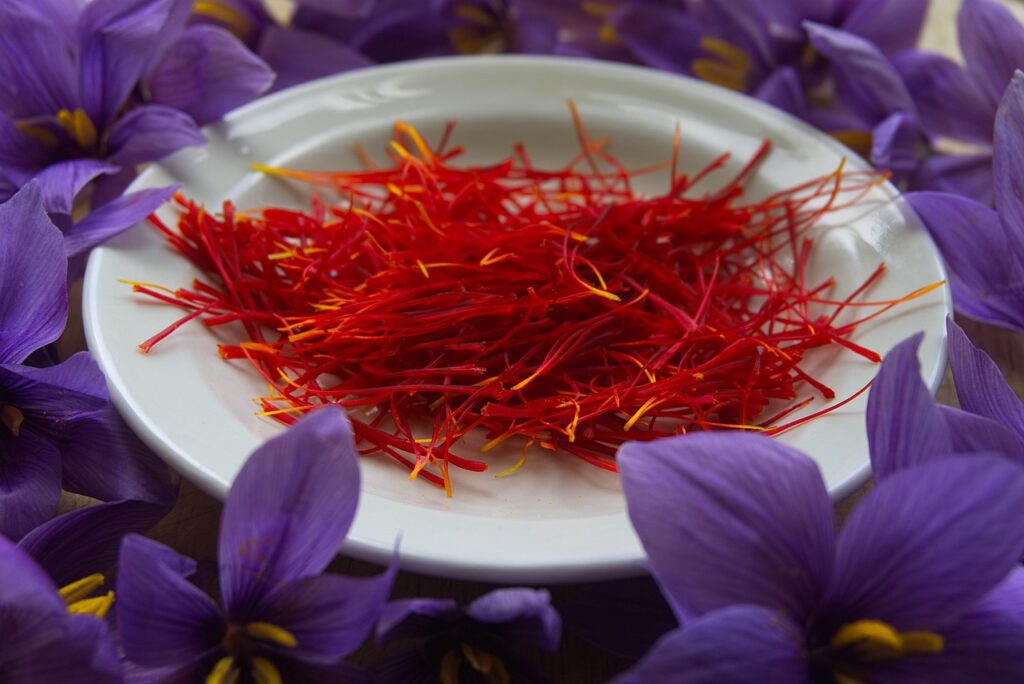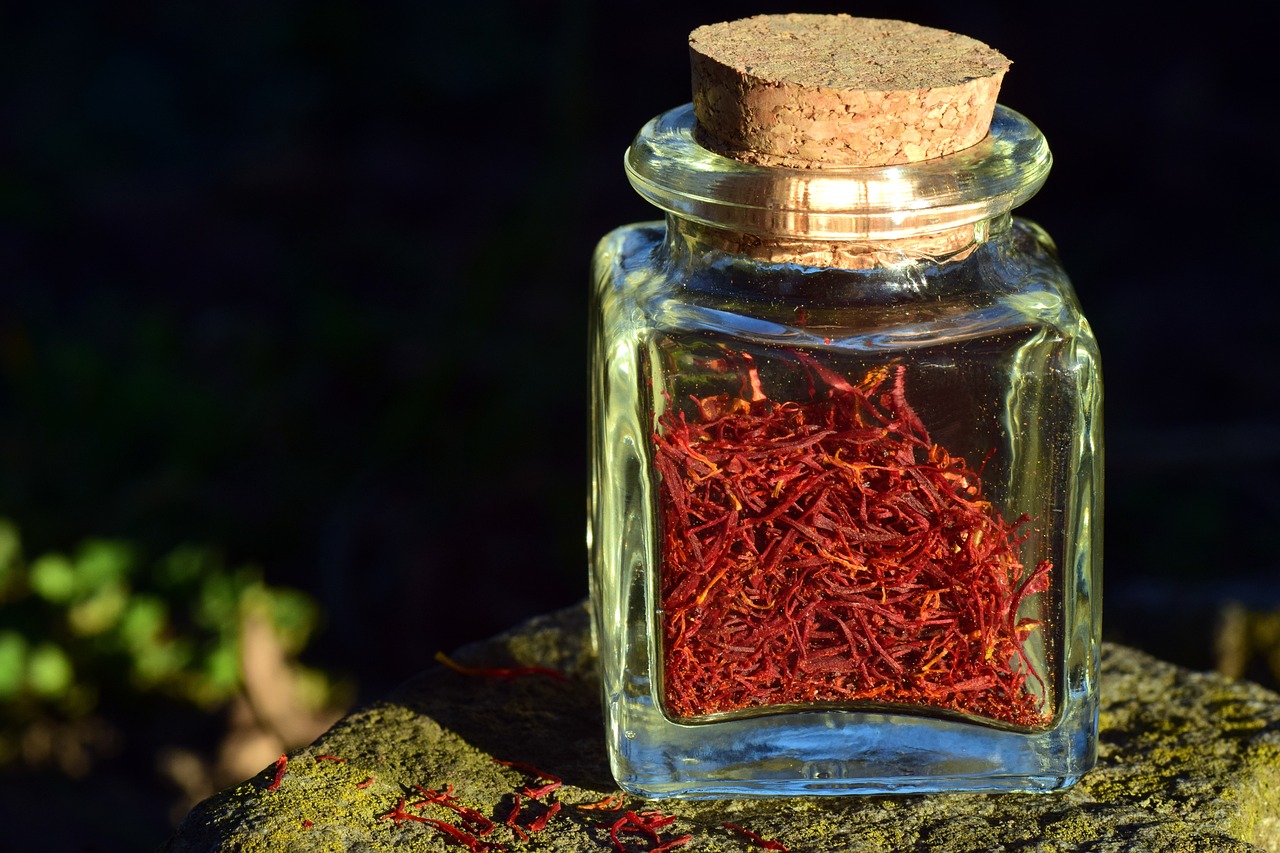What Does Saffron Taste Like? Introduction To Saffron
What Is Saffron And Why Is It So Special?
Saffron is a highly sought-after spice made from the red stigmas of the purple saffron crocus flower (Crocus sativus). The three delicate stigmas are hand-picked, dried, and used either whole or ground to create the spice known as saffron. This spice has a unique golden hue, a warm floral flavor accompanied by a subtle bitterness, and a delicate sweetness that make it an irreplaceable ingredient in various cuisines across the globe.


The History And Significance Of Saffron
Saffron has been used for thousands of years in different regions of the world for medicinal purposes, culinary applications, and as a dye for textiles. Its origin is believed to be in central Asia, where it was initially cultivated and then traded to other regions, including India, the Mediterranean, and Europe. The production of saffron flowers is labor-intensive and requires skilled laborers to hand-pick the stigmas. This has contributed to its exclusivity and high price, making it one of the most expensive spices in the world.
Saffron remains an essential ingredient in various dishes across the globe. It adds both flavor and striking color to dishes, making it a valuable component in the culinary industry. Chefs and food enthusiasts alike continue to explore and seek creative ways to incorporate saffron into their cooking, allowing them to experience the magic of saffron’s intricate taste and aroma.
Saffron Flavor Profile
Subtle Earthy And Grassy Flavor With Sweet Floral And Honey Undertones
The flavor profile of saffron is made up of sweet, earthy, and floral tones, which creates a nuanced, delicate, and complex flavor. The spice has a distinctly warm floral taste accompanied by a subtle bitterness and a delicate sweetness. When seeking to describe the flavor profile of saffron, it’s often compared to honey, grass, and earthy tones. The bitter notes balance the sweet flavor, making it a perfect all-around spice that can work in numerous dishes across various culinary styles.
Aroma And Taste Of Saffron
The aroma of saffron is unmistakable, with an earthy, grassy scent reminiscent of fresh hay. The sweet, floral aroma with hints of honey combined with the warm earthy aroma of saffron make it one of the most recognizable spices worldwide. The taste and aroma are often described as complex, with flavors varying based on its origin.


Chefs and culinary enthusiasts often mix saffron with various other spices and ingredients, allowing them to experience the magic of the intricate taste and aroma of saffron in different dishes. The golden hue that saffron adds to dishes makes it appealing to the eye and a perfect ingredient for photography.
Overall, saffron remains one of the most expensive and sought-after spices in the world, primarily due to its unique taste and aroma and its labor-intensive production process. Whether used in sweet or savory dishes, saffron remains an irreplaceable ingredient in cuisines worldwide.
Health Benefits Of Saffron
Antioxidant And Anti-inflammatory Properties
Saffron is a powerhouse of antioxidants like crocin, crocetin, and safranal, which help neutralize harmful free radicals. These potent antioxidants combat oxidative stress and offer protection against various health conditions. Saffron has also been found to possess anti-inflammatory properties, which makes it a valuable ingredient in medicinal and culinary contexts.
Effects On Mood, Memory, And Overall Health
Studies have suggested that saffron may have positive effects on mood and mental well-being. The spice has been found to alleviate symptoms of depression and anxiety, and improve mood and memory in adults. Additionally, saffron has been studied for its potential neuroprotective effects to prevent the onset and progression of neurodegenerative diseases.
Furthermore, saffron may help regulate blood glucose levels and reduce cholesterol levels, making it a beneficial dietary supplement for individuals with diabetes and high cholesterol. The spice has also been investigated for its anti-cancer properties, and early research suggests it may have promising effects in preventing and treating certain types of cancer.


In summary, saffron’s multitude of health benefits makes it a valuable ingredient in both culinary and medicinal practices. Its antioxidant and anti-inflammatory properties, effects on mood and memory, and potential to aid in blood glucose and cholesterol regulation, and anti-cancer effects, highlight the remarkable potential of this exotic spice. Consider incorporating saffron into your diet to take advantage of its outstanding array of health benefits.
How To Use Saffron In Cooking
Using Saffron In Recipes
Saffron is a versatile spice that can be used in a variety of recipes. It adds a unique flavor and aroma to dishes and can enhance the taste profile of sweet or savory recipes. Some common dishes that use saffron include paella, risotto, and bouillabaisse. The spice can also be used to add a touch of sophistication to desserts such as ice cream or custards.
When cooking with saffron, it is important to use a small amount as the flavor is quite strong. Generally, a pinch of saffron threads or 1-2 teaspoons of saffron powder is enough for a recipe that serves four people. It is important to soak saffron in warm water or milk before using it in a recipe to help release its unique flavor and color.
Techniques For Preparing Saffron
When preparing saffron, there are a few techniques that can be used to extract the full flavor and color of the spice. One of the most common techniques is to soak the strands in hot water or milk for at least 30 minutes. This technique not only helps to release the flavor, but it also adds a rich yellow color to dishes.
Another technique is to grind saffron threads into a powder using a mortar and pestle. This powder can then be added directly to recipes, or it can be made into a paste by mixing it with a small amount of water.
Overall, saffron’s unique taste profile and versatility make it a prized ingredient in many dishes, both sweet and savory. By using the proper techniques when preparing saffron, you can unlock its full potential and elevate your recipes to a whole new level.
Saffron Quality And Grading
Types Of Saffron And Their Differences
Saffron comes in three types: Iranian, Spanish, and Kashmiri. Iran produces almost 90% of the world’s saffron, which is considered the highest quality. Spanish saffron has a lower quality but is more affordable, and Kashmiri saffron is known for its unique flavor and aroma. The main difference between these types of saffron is the concentration of crocin, picrocrocin, and safranal, which are the compounds responsible for saffron’s color, flavor, and aroma.
Grading Systems For Saffron
Saffron grading systems vary among countries and regions, but generally, they are based on the color, aroma, and flavor of the spice. Iranian saffron, for example, is graded based on four categories: sargol, pushal, bunched, and white. Sargol is the highest grade and consists of only the red stigmas of saffron threads. Pushal is the lower part of the saffron thread with some yellow styles. Bunched contains both stigmas and yellow styles, and White contains only the white part of the saffron thread.
Spanish saffron grading is based on three categories: coupe, mancha, and rio. Coupe is the highest grade and consists only of red stigmas. Mancha contains some styles, and rio contains a high percentage of yellow styles.


Kashmiri saffron is graded based on the amount of floral waste, including plant parts and non-red stigmas, contained in the spice. The highest-grade Kashmiri saffron is called “Mongra”, which contains only the red stigmas and is known for its intense flavor and aroma.
In conclusion, understanding saffron’s quality and grading can help you choose the best type of saffron for your recipe and ensure that you are getting a high-quality product. Remember to use saffron sparingly and to follow proper techniques for preparing the spice to get the most out of its unique taste and aroma.
The Origin Of Our Saffron
Our Source For Saffron And Why We Chose It
The saffron we offer at Rumi Spice is sourced directly from Afghan farmers. We believe that supporting Afghan farmers is essential in rebuilding the country’s economy and promoting stability in the region. Our partnership with Afghan farmers enables us to provide high-quality saffron, while also supporting sustainable and ethical practices in the industry.
Afghanistan has a rich history of saffron production, and the country’s saffron is known for its unique flavor and aroma. Our saffron threads are hand-picked by local farmers, ensuring that only the highest quality threads make it to your kitchen.
Sustainable And Ethical Practices
At Rumi Spice, we are committed to sustainable and ethical practices in the saffron industry. We work directly with Afghan farmers to provide fair prices for their crops, which supports their livelihoods and strengthens their communities.
Our saffron cultivation methods are also sustainable, as we encourage farmers to use natural fertilizers and avoid harmful pesticides. We believe that promoting sustainable and ethical practices in the industry not only benefits farmers and the environment, but also results in higher-quality saffron for our customers.
In conclusion, our saffron is sourced directly from Afghan farmers who use sustainable and ethical practices in cultivation. By purchasing our saffron, you can support these practices and enjoy the unique flavor and aroma of high-quality Afghan saffron.
Saffron Production Process
How Saffron Is Grown And Harvested
Saffron is a highly prized spice that is cultivated and harvested by hand. It comes from the stigmas of the Crocus sativus flower, which only blooms for a few weeks in the autumn. The flowers are hand-picked and the stigmas are carefully removed and dried to produce the saffron threads.
Saffron thrives in dry, arid climates, and is typically grown in regions such as Iran, Spain, and Afghanistan. In Afghanistan, saffron is mainly grown in the Herat province, where the weather is hot and dry.
The Labor-intensive Process Of Producing Saffron
Producing saffron is a labor-intensive process that requires great attention to detail and manual labor. The flowers must be picked early in the morning when they are still closed, and then the delicate stigmas must be carefully removed and dried. It takes around 75,000 flowers to produce just one pound of dried saffron threads.
The production process is further complicated by the fact that saffron is often harvested by hand by women and children. This means that growers must pay close attention to labor laws and ensure that their workers are treated fairly and paid a fair wage.


Once the saffron threads have been dried, they can be used for a variety of culinary and medicinal purposes. Saffron is used in many different types of dishes, including paella, risotto, and biryani, and is prized for its unique flavor and aroma.
Overall, the process of producing saffron is incredibly labor-intensive and requires great attention to detail and manual labor. However, the end result is a highly prized spice that is sought after by chefs and food lovers around the world.
Storing And Preserving Saffron
Proper Storage Techniques For Longevity
To preserve the delicate flavor and fragrance of saffron, proper storage is essential. The following tips can help prolong the shelf life of saffron:
- Store saffron in an airtight container to protect it from light and moisture.
- Keep saffron in a cool, dark place away from direct sunlight and heat. Ideally, it should be stored in a pantry or cupboard.
- Avoid storing saffron in the refrigerator or freezer, as temperatures that are too low can damage its delicate flavor and aroma.
- Use saffron within two to three years of purchase to ensure maximum freshness.
How To Tell If Saffron Has Gone Bad
Saffron that has gone bad can have a musty or stale scent and a dull color. It may also lose its flavor and aroma over time. To ensure that your saffron is still good, you can perform a simple test:
- Take a small amount of saffron and rub it between your fingers. If it has a strong, rich aroma and a bright red color, it is likely still fresh.
- If the saffron has a stale scent and a dull or faded color, it may be past its prime.
By following these tips, you can ensure that your saffron stays fresh and flavorful, allowing you to fully enjoy its unique qualities in your culinary creations.
Storing And Preserving Saffron
Proper Storage Techniques For Longevity
Saffron is a delicate spice that needs to be stored properly to preserve its unique flavor and fragrance. To ensure that saffron remains fresh for a long time, it is essential to store it correctly. Here are some tips for proper saffron storage:
- Store saffron in an airtight container to protect it from light and moisture.
- Keep saffron in a cool, dark place away from direct sunlight and heat.
- Avoid storing saffron in the refrigerator or freezer as low temperatures can damage its delicate flavor and aroma.
- Use saffron within two to three years of purchase to ensure maximum freshness.
How To Tell If Saffron Has Gone Bad
Saffron that has gone bad has a stale scent and a dull color. Over time, saffron can also lose its flavor and aroma. To check if saffron is still fresh, you can perform a simple test:
- Take a small amount of saffron and rub it between your fingers. If it has a strong, rich aroma and a bright red color, it is likely still fresh.
- If the saffron has a stale scent and a dull or faded color, it may be past its prime.
By following these tips, you can ensure that your saffron stays fresh and flavorful, allowing you to use it to its fullest potential in your culinary creations.
Summary Of Saffron’s Unique Flavor Profile
Saffron’s taste notes are complex, with a subtle sweetness and a slight bitter taste. It adds a delightful sensory experience to dishes with its perfect blend of aroma and taste. Its unique flavor profile and characteristics make it a highly sought-after spice in the culinary world.
Final Thoughts And Recommendations For Trying Saffron.
Saffron is a versatile spice that can elevate the taste of different dishes to another level. If you have not yet tried saffron, we recommend that you experiment with it in various cuisines to expand your palate and discover new flavor combinations.
Mastering the usage of saffron in your culinary creations can help you achieve the perfect balance of flavors. Just remember to store saffron properly, and it will remain fresh and flavorful for an extended period.
Q: What is saffron?
A: Saffron is a spice derived from the flower of the Crocus sativus plant. It is known for its vibrant red-orange color, complex flavor profile, and high cost.
Q: What does saffron taste like?
A: Saffron has a unique flavor that is difficult to describe. It has a floral, sweet, and somewhat earthy taste with hints of bitterness. Its flavor is often described as subtle, delicate, and slightly pungent.
Q: What dishes use saffron?
A: Saffron is used in a variety of dishes, particularly in Middle Eastern, Mediterranean, and Indian cuisine. It is commonly used in rice dishes such as paella and biryani, as well as in soups, stews, and curries.
Q: How is saffron used in cooking?
A: Saffron is typically sold in thin threads or powder form. To use saffron in cooking, it is usually steeped in hot liquid such as water, broth, or milk to release its flavor and color. It can also be ground and sprinkled directly onto dishes for a more intense flavor.
Q: What are the health benefits of saffron?
A: Saffron has been used for centuries for its medicinal properties. It is believed to have anti-inflammatory, antioxidant, and anti-depressant properties. It may also aid in digestion and promote healthy skin.
Q: Are there any side effects of consuming saffron?
A: While saffron is generally safe to consume in small amounts, excessive consumption may result in side effects such as nausea, vomiting, dizziness, and even death in extreme cases. It is recommended to consume saffron in moderation and consult a healthcare professional before using it for medicinal purposes.
Overall, saffron has a unique and complex flavor that adds a distinct element to dishes. Its vibrant color and health benefits make it a prized spice in many cultures.



Hey there! If you’re a fan of authentic Mexican cuisine, you’re in for a treat with Humberto Cruz at pointcafeny.com. They take immense pride in serving their customers with home-cooked, genuine Mexican dishes crafted with the finest ingredients. From flavorful salsa to mouthwatering tamales and enchiladas, they offer an experience that brings the taste of family food from back home right to your table. Don’t forget to check out their tempting Daily Specials for a delightful culinary adventure!
